Posted on March 11th, 2010 in AK Book Excerpts
 Cindy Milstein’s new book, Anarchism and Its Aspirations, has been printed and is on its way to our warehouse. It’ll be available at the Bay Area Anarchist Bookfair this weekend (where Cindy will be giving two talks).
Cindy Milstein’s new book, Anarchism and Its Aspirations, has been printed and is on its way to our warehouse. It’ll be available at the Bay Area Anarchist Bookfair this weekend (where Cindy will be giving two talks).
For those of you who can’t make the bookfair, you can order it now (at a 25% discount!).
Wherever you are, here’s a taste of what’s in store: two brief excerpts lifted from the book’s title essay. Enjoy!
♦♦♦
The aim of anarchism is to stimulate forces that propel society in a libertarian direction.
—Sam Dolgoff, The Relevance of Anarchism to Modern Society, 1970
Classical anarchism’s aims were no bulwark against the brutal transformations that swept the globe with the rise of actually existing communism and fascism. Historical forces drove society in a murderous direction. Anarchism did not disappear during this time. Yet its ranks were decimated. Touchstone figures were killed, including Gustav Landauer by protofascists following the Bavarian Revolution in 1919 and Erich Mühsam by Nazis in the Oranienburg concentration camp in 1934. Others died in prison, like Ricardo Flores Magón in 1922, and some committed suicide, such as Alexander Berkman in 1936. Anarchists were increasingly isolated. Kropotkin’s death in 1921 marked the last mass gathering of anarchists—for his funeral procession, and then only with Vladimir Lenin’s permission—in Russia until 1987. Thousands of anarchists worldwide were incarcerated, exiled, or slaughtered. They were victims of repressions like the Red Scare in the United States and purges of radical opposition by numerous Communist parties. As a result, anarchism became far less vibrant, a ghost of itself. This made it difficult for people to discover the politics, further reducing the number of anarchists and anarchistic efforts. It was as if the antiauthoritarian Left skipped a generation or two.
At the same time, the world itself was transformed—but in a polar opposite way from anything that anarchists had advocated. Fascism, Bolshevism, and Maoism; the rise of the United States as a world superpower; the birth of multinational financial institutions along with the “advancement” of capitalism; the cold war with its nuclear threat: these and other emergent phenomena dramatically expanded the forms of domination that any liberatory politics needed to address. Attempts to rebuild anarchism were slow going, but never truly disappeared. In the postwar era, through the 1960s and beyond, anarchism struggled to tailor itself for the late twentieth century. It gained insight from other overlapping or like-minded movements, such as radical feminism and queer liberation, or the Autonomen in Germany and Zapatistas in Mexico. It inspired, both explicitly and in less obvious ways, everything from the playful urban politics of Amsterdam’s Provos to new forms of radical ecology like the antinuclear movement and Earth First! to the British poll tax rebellion.28 While anarchism seemed behind the curve on some issues—the collapse of Communism and the subsequent rise of unipolar neoliberalism, for instance—it continued to grow and develop.
By the close of the twentieth century, the “battle of Seattle” in 1999 was, for anarchism, just one manifestation of a whole chain of reinventions within its own tradition.29 Often seen as the birth of a “new” anarchism, the now-famous role of anarchists in Seattle’s mass mobilization against—and successful shutdown of—the World Trade Organization meetings was more a marker of something that had already occurred: a modern anarchism had developed in a direct, however hidden or circuitous, line from its “classical” past. What Seattle did do, though, was spotlight this reinvigorated anarchism, whether via images of “black bloc” anarchists throwing bricks through Starbucks windows, or explanations of how the affinity group and spokescouncil model worked in practice.30 Mostly, it gave visibility and voice to anarchism in general, helping it recapture the political imagination, in league with a host of other “movements from below” around the world.
The modernization of anarchism is also marked by what at times seems an almost dizzying array of different emphases. This increasing multiplicity is frequently a healthy development, challenging anarchism to remain germane to today’s world, and draw its reconstructive visions from potentialities within the present. Yet anarchism is not immune from the increasing fragmentation and immediacy, among other conditions, that characterize much of contemporary capitalist society. It is just as damaged by the phenomena it decries. Even as anarchists advocate a community of communities, they are, like most people today, alienated from any sense of place and hence each other. Nonetheless, there remains a profound sense of recognition between anarchists, based on a shared set of distinct values, which in turn structure their lives and projects. So let’s return to this amorphous entity called anarchism, in order to add flesh to what still may feel like a vague definition by exploring the constellation of sensibilities that describes all anarchists.
—-
A Revolutionary Stance
First and foremost, anarchism is a revolutionary political philosophy. That is, anarchism is thoroughly radical in the true sense of the word: to get at the root or origin of phenomena, and from there to make dramatic changes in the existing conditions. Anarchism aspires to fundamentally transform society, toward expansive notions of individual and social freedom. Much of the time, in practice, this means engaging in various “reforms” or improvements, but ones that at the same time attempt to explicitly articulate a revolutionary politics. This reform-pointing-to-revolution is certainly hard to navigate, much less implement. Debates within anarchism relating to strategies and tactics hinge on this question, and rightly so, since capitalism, in particular, has an astonishing knack for recuperating anything that seems to stand in its way.
Despite the difficulties, anarchists never advocate a purely reformist attitude. They try their best never to participate in reform as an end in itself, or to bring about improvements that also make the present social order look attractive. Their efforts to move from “here” to “there” intentionally highlight how current social arrangements cannot, by their own raison d’être, meet everyone’s needs and desires. Anarchists do not “rest content with the ideal of a future society without overlordship,” as anarcho-syndicalist Rudolf Rocker put it long ago; they simultaneously direct their organizing efforts at, for one, “restricting the activities of the state and blocking its influence in every department of social life wherever they see an opportunity.”31 Anarchism is not satisfied with remaining on the surface, merely tinkering to make a damaged world a little less damaging. It is a thoroughgoing critique aimed at a thoroughgoing reimagining and restructuring of society. It views this as essential if everyone is to be free, and if humanity is to harmonize itself with the nonhuman world.
As mentioned earlier, anarchism from the start focused on what appeared as the two biggest stumbling blocks to a libertarian society: capitalism and the state. This pair, sadly, are still the predominant forms of social immiseration and control. Capitalism and statecraft loom large in terms of naturalizing—and thereby being at the root of—this immiseration and control. Their separate yet often-interrelated internal logics consolidate power monopolies for a few, always at the expense of the many. This demands that each system must both continually expand and mask its dominion. To survive, they have to make it seem normal that most people are materially impoverished and disenfranchised as economic actors, and socially impoverished and disenfranchised as political actors. They have to restructure social relations in their own image—as unthinkingly assumed ways of being and acting. The world that most of humanity produces is, as a result, denied to the vast majority, and a relative handful get to make binding decisions over all of life. Anarchism is therefore staunchly anticapitalist and antistatist, which ensures that it is a revolutionary politics, since battling such primary systems necessarily means getting to the root of them. Moving beyond capitalism and states would entail nothing less than turning the world upside down, breaking up all monopolies, and reconstituting everything in common—from institutions to ethics to everyday life.
So, for example, whereas many in the global and now climate justice movements focus on corporations as key, anarchists see these entities as only one piece of capitalism, and a piece that if removed, wouldn’t destroy capitalism—bad as corporations may be. One can have capitalism without corporations. Capitalism’s essence—ensuring that society is forged around compulsory social relations along with inequities in power and material conditions—would remain in place. And given capitalism’s grow-or-die logic, small-scale capitalism would by definition unfold into a larger scale again. Or as contemporary networked and informational capitalistic structures indicate, allegedly localized capitalism can be a way to hide an increasing concentration of social control and injustice. Capitalism itself, in its totality, and because it strives toward totality, is the root problem. Anarchists, then, look to wholly undo the hegemony of capitalist economic structures and values, or the many components that mark capitalism as a system—from corporations, banks, and private property, to profit, bosses, and wage labor, to alienation and commodification.
Notes
28. A sampler of some histories of these movements includes Alice Echols, Daring to Be Bad: Radical Feminism in America, 1967–1975 (Minneapolis: University of Minnesota Press, 1989); Andy Cornell, “Anarchism and the Movement for a New Society: Direct Action and Prefigurative Community in the 1970s and 1980s,” Perspectives (2009), available at http://anarchiststudies.org/node/292; Tommi Avicolli Mecca, ed., Smash the Church, Smash the State! The Early Years of Gay Liberation (San Francisco: City Lights Publishers, 2009); George Katsiaficas, The Subversion of Politics: European Autonomous Social Movements and the Decolonization of Everyday Life (Oakland, CA: AK Press, 2006); Ziga Vodovnik, ed., YA BASTA! Ten Years of the Zapatista Uprising: Writings of Subcomandante Insurgente Marcos (Oakland, CA: AK Press, 2004); Richard Kempton, Provo: Amsterdam’s Anarchist Revolt (Brooklyn: Autonomedia, 2007); Barbara Epstein, Political Protest and Cultural Revolution: Nonviolent Direct Action in the 1970s and 1980s (Berkeley: University of California Press, 1991); Earth First! Journal, available at http://www.earthfirstjournal.org; Danny Burns, Poll Tax Rebellion (Scotland: AK Press, 1992).
29. While there are numerous books, articles, films, and news accounts about this mobilization, many written soon after Seattle 1999, the most recent one is David Solnit and Rebecca Solnit, The Battle of the Story of the “Battle of Seattle” (Oakland, CA: AK Press, 2009), timed for the tenth anniversary.
31. Rudolf Rocker, Anarcho-Syndicalism: Theory and Practice (1938; repr., Oakland, CA: AK Press, 2004), 73.
Posted on March 10th, 2010 in AK Allies, Anarchist Publishers, Happenings
Those of you from the Bay Area have probably (hopefully? if you read our blog, at least) already heard that this weekend is the 15th Annual Bay Area Anarchist Bookfair. We’ll be there all weekend, showing off our latest and greatest published books and distro items. Get three new AK titles hot off the press! Witness the dramatic premiere of four new t-shirt designs from John Yates! Check out our whole table of sale items for $5 or less! Plus of course you can hear a slew of AK authors speaking and check out a whole building full of awesome anarchist publishers, distros, infoshops, artists, and more. Seriously, if you are around, you have to go. You’ll be kicking yourself until next March if you don’t.
Here, again, are the details:
15th Annual Bay Area Anarchist Bookfair!
Saturday, March 13 from 10:00AM to 6:00PM
AND Sunday, March 14 from 11:00AM to 5:00 PM
SF County Fair Building @ Golden Gate Park, 9th Avenue & Lincoln Way, San Francisco
FREE
And you can get more complete info here.
But wait, that’s not all that’s going on this week! There are lots of other events being organized around the bookfair too. So whether you’re coming in from out of town and looking to be entertained, or you’re a local just wondering where all the cool kids will be hanging out, let AK Press be your guide! Here are some of the choice events that will be going on this week. Hope we’ll see you all out and about—we’ll be (a few of) the nerds in the AK Press hoodies…
 Wednesday, March 10 at 7:30PM
Wednesday, March 10 at 7:30PM
Paper Politics: Socially Engaged Printmaking Today
CounterPULSE, 1310 Mission Street (at 9th), San Francisco
FREE
Join AK author Josh MacPhee (Realizing the Impossible and a dozen other political print and poster makers as they discuss Josh’s new book on PM Press, Paper Politics, as well as the current state of political graphics making: What are we doing? Why? And is it working? Short presentations by a few artists will be followed by a large roundtable discussion with audience participation encouraged.
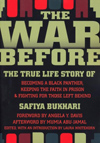 Thursday, March 11 at 7:00PM
Thursday, March 11 at 7:00PM
The War Before: The Writings of Safiya Bukhari (Bay Area Release Event)
Women’s Building, 3453 18th Street, San Francisco
FREE
The Bay Area release event for the new book The War Before, just released by The Feminist Press! The book traces Safiya Bukhari’s lifelong commitment as an advocate for the rights of the oppressed—from middle-class student to Black Panther to political prisoner—and shows how past social justice movements have paved the way for the today’s struggles. This book release event features Safiya Bukhari’s daughter, Wonda Jones; the book’s editor, Laura Whitehorn; former Panther Kiilu Nyasha; and other guests.
 Thursday, March 11 from 7:00PM–midnight
Thursday, March 11 from 7:00PM–midnight
Defiant Proclamations: Radical Posters from the 1960s to the Present
CELLspace Gallery, 2050 Bryant Street, San Francisco
FREE
For decades, Bay Area walls have been pasted with bold art and pertinent messages about politics, practices, and the abuses of contemporary mainstream culture. Speaking from both inside and outside of the frameworks of organized labor and left movements, individual artists and collectives have broadcast defiant proclamations with ink and paper. This one-night-only exhibit of posters, handbills, and artifacts will feature works old and new, giving a glimpse of the broad range of opinions and styles that have papered walls across the region.
Friday, March 12 from 7:00-10:00PM
Anarchist Café
St. Martin de Porres House, 225 Potrero Avenue (between 15th & 16th), San Francisco
$5–20 suggested donation
Gather with your fellow anarchists for food, coffee, tea and performances indoors and a covered hang-out space outdoors. Dinner will be served until 9pm or until the food runs out, whichever comes first. No drugs or alcohol please! If you are interested in volunteering at the café contact Mike at mikee1051@yahoo.com; if you would like to perform, email marcus@midnightspecial.net.
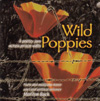 Saturday, March 13 at 7:00PM
Saturday, March 13 at 7:00PM
Sparks Fly: An evening in honor of Marilyn Buck
Uptown Body & Fender, 401 26th Street, Oakland
$10–50 suggested donation
After 25 years, political prisoner Marilyn Buck is scheduled to get out of jail later this year. Jailed for actions in solidarity with the Black liberation and anti-war movements, Marilyn has been a voice for justice during her entire incarceration. Come out for an art auction, poetry, music, and speakers—then a dance party starting at 10PM—to help raise funds for her release.
 Sunday, March 14 at 7:00PM
Sunday, March 14 at 7:00PM
Visions of the Urban Future: Discussion & book signing with Matt Hern
Studio for Urban Projects, 3579 17th Street (at Dolores), San Francisco
FREE
If we want to preserve what’s still left of the natural world, we need to stop using so much of it. And cities are the best chance we have left for a sustainable future…but only if they remain vibrant, dynamic spaces that are unfolded by millions of people working together, not by master plans and planners. What will it take to make our cities truly sustainable? Join AK author Matt Hern for a discussion of his new book Common Ground in a Liquid City: Essays in Defense of an Urban Future.
Monday, March 15 at 7:00PM
An Anarchist Look at the Barcelona Squatting Movement, with Peter Gelderloos
Station 40, 3030B 16th Street, San Francisco
$3–5 suggested donation
Most of us have heard stories about (or experienced firsthand) the squatting movement in Spain. But we frequently fail to think about the effect that this network of squatted and autonomous spaces has on the social activist movement in Europe, generally, and Barcelona, specifically. How does the prevalence of squatted spaces impact the anarchist world in ways that are structurally different from the anarchist world in the United States? What do we stand to learn from each other? Author and activist Peter Gelderloos, who made headlines in 2007 when he was arrested in conjunction with a squatters’ protest in Barcelona, will explore these and other aspects of the squatting movement.
 Also going on all week (March 9–16)
Also going on all week (March 9–16)
8 Days of Anarchy
A study group, a film screening, the BASTARD conference, and a handful of other events.
Go here for more information.
Posted on March 10th, 2010 in AK Authors!, Happenings
Book fair time again in San Francisco. Another year, another whirlwind weekend. We thought we’d take a break in our preparations to let you know which AK authors will be presenting this year at Bound Together’s 15th annual event. For a full list of speakers go to the official site.
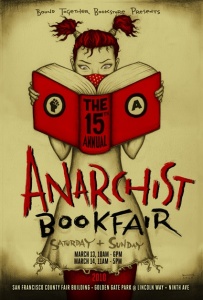 AK Authors who are speaking solo:
AK Authors who are speaking solo:
Margaret Killjoy (ed. Mythmakers and Lawbreakers), 3:30PM on Saturday
Void Network (ed. We Are an Image From the Future), 4PM on Saturday (in Cafe)
Cindy Milstein (Anarchism and its Aspirations), 11AM on Sunday
Matt Hern (Everywhere all the Time, ed. and Common Ground in a Liquid City), 11:30AM on Sunday
Ward Churchill (On the Justice of Roosting Chickens, Pacifism as Pathology, Since Predator Came, Life in Occupied America, Doing Time, Pacifism and Pathology, In a Pig’s Eye, contributor: Academic Repression, Red State Rebels, Monkeywrenching the New World Order) 4PM on Sunday
AK Authors who are speaking on panels:
IAS Panel w/Cindy Milstein (Anarchism and its Aspirations), 11AM on Saturday
Radical Parenting Panel w/Jessica Mills (My Mother Wears Combat Boots), 12PM on Sunday
Socially Engaged Printmaking Panel w/Josh MacPhee (Realizing the Impossible and Signs of Change), 1PM on Sunday
Contributors to AK Books who are also speaking:
Roxanne Dunbar-Ortiz (Quiet Rumours, Red State Rebels, Uses of a Whirlwind)
Andrej Grubacic (Uses of a Whirlwind)
John Zerzan (Igniting a Revolution)
Kim Stanley Robinson (Mythmakers and Lawbreakers)
And of course many other friends, authors, and contributors will be attending and tabling this weekend. See you there!
Posted on March 8th, 2010 in AK Distribution
Hello dearest hearts,
Another month, and so another series of AK backlist that we’re offering at 50% off the list price. I am biased of course, but really, these are all great, and you should have already got them! Procrastination has its reward!
 Anarchist Voices: An Oral History of Anarchism in America
Anarchist Voices: An Oral History of Anarchism in America
Edited by Paul Avrich
Starting out with a bang, are we not?
Unabridged! The anarchists represented in this book were active between the 1880s and the 1930s and represent all schools of anarchism. Their stories provide a wealth of personal detail about such anarchist luminaries as Emma Goldman and Sacco and Vanzetti, as well as their own selves. (More than once, people have come up to us when we are tabling and told us their granny is in it!) This work of impeccable scholarship is an invaluable resource not only for scholars of anarchism but also for those studying immigration, ethnic politics, education, and labor history.
Now just $14!
 You Can’t Win
You Can’t Win
By Jack Black
A legendary book, bestseller in 1926, and hovering at the edge of our memory since; William Burroughs’ (who writes the introduction) and my landlady’s favourite book! A journey into the hobo underworld, freight hopping around the still-Wild West, becoming a highwayman and member of the yegg (criminal) brotherhood, getting hooked on opium, doing stints in jail, or escaping, often with the assistance of crooked cops or judges. Our lost history revived. Summer vacation reading in March!
Now just $8!
 Since Predator Came: Notes from the Struggle for American Indian Liberation
Since Predator Came: Notes from the Struggle for American Indian Liberation
By Ward Churchill
Rational, angry, yet ultimately hopeful, Ward Churchill’s is a leading voice against the ongoing genocide perpetrated on Native American peoples. Intellectually cogent while remaining accessible to the general reader, the eighteen essays herein will challenge you to think, and then act, in the fight for justice waged since Columbus’ arrival.
Now just $11!
 Reinventing Anarchy, Again
Reinventing Anarchy, Again
Edited by Howard Ehrlich
This book brings together the major currents of social anarchist theory in a collection of some of the most important writers from the United States, Canada, England, and Australia. The book is organized into eight sections, which are “What is Anarchism?,” “The State and Social Organization,” “Moving Toward Anarchist Society,” “Anarcha-feminism,” “Work,” “The Culture of Anarchy,” “The Liberation of Self,” and, finally, “Reinventing Anarchist Tactics.” A must have!
Now just $12.50!
 Direct Action: Memoirs of an Urban Guerilla
Direct Action: Memoirs of an Urban Guerilla
By Ann Hansen
The Vancouver 5, or Squamish 5, were five Canadians convicted in the early 80s of (successfully) bombing a hydro-electric power sub-station, the Litton Systems plant in Toronto, where components for Cruise Missiles were being made, and several Red Hot Video stores, accused of selling violent pornography. Now, finally, twenty years later, Ann Hansen, who served seven years for her involvement, tells the true gripping saga of an anarchist guerilla group.
Now just $10!
 A Living Revolution: Anarchism in the Kibbutz Movement
A Living Revolution: Anarchism in the Kibbutz Movement
By James Horrox
This is new, so obviously you should have it, but for those stragglers…
“These pages bring to life the most radical and passionate voices that shaped the second and third waves of Jewish immigration to Palestine, and also encounter those contemporary projects working to revive the spirit of the kibbutz as it was intended to be, despite, and because of, their predecessors’ fate.” —Uri Gordon, from the foreword
Now just $9!
 The London Years
The London Years
Rudolf Rocker
From the Jewish Bakers Union to the 1912 tailor’s general strike, which abolished sweatshops, The London Years chronicles the vibrant Jewish immigrant community in London, and how it organized, and fought back against poverty, anti-Semitism, and anti-immigrant hysteria. An incredible window into this now largely-forgotten world, and an engaging autobiography of a remarkable man. This edition includes a lengthy introduction by Colin Ward (perhaps you’re familiar with his work?), long-time anarchist agitator, propagandist, and editor.
Now just $11!
And it has been pointed out to me that I appear to be giving blog readers the finger in that picture last week. Day three of inventory, the most hairy part—I was giving Suzanne the finger, sillies!
Posted on March 5th, 2010 in AK Distribution
Hey folks. There are several new and exciting titles that have poured into our warehouse in the past couple of weeks, so I’ll go ahead and cut to the chase:
 What Kind of Liberation? Women and the Occupation of Iraq
What Kind of Liberation? Women and the Occupation of Iraq
Nicola Pratt & Nadje Al-Ali
Here we have a succinct study on the shifting roles of Iraqi women, from all sectors of society, living under the current U.S. military occupation in Iraq. This book further discredits the Dubbya administration’s initial proclamations of seeking freedom for the women of Iraq through military force and argues that the situation for these women has actually worsened due to U.S. interference.
 Procesos revolucionarios en América Latina
Procesos revolucionarios en América Latina
Alberto Prieto
Adding to our growing Spanish-language section, this book comprehensively highlights various struggles, rebellions, revolutions, and insurrections that have taken place throughout the centuries in Latin America, from Túpac Amaru to Jose Martí, from Simon Bolívar to Augusto Sandino, and many many more.
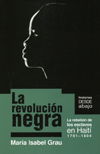 La revolución negra: La rebelión de los esclavos en Haití, 1791–1804
La revolución negra: La rebelión de los esclavos en Haití, 1791–1804
Maria Isable Grau
More new books in Spanish! This book is part of Ocean Press’ History from Below series and looks at the history of the armed Haitian struggle against French colonization led by L’Overture—a rebellion inspired in part, ironically, by the French Revolution.
 The War Before: The True Life Story of Becoming A Black Panther, Keeping the Faith in Prison & Fighting for Those Left Behind
The War Before: The True Life Story of Becoming A Black Panther, Keeping the Faith in Prison & Fighting for Those Left Behind
Safiya Bukhari
I am very excited about this book. It is full of mixed-documents that piece together the life of a woman who opted out of the false comforts of Black middle class assimilationism and instead decided to dedicate her life, full force, to bringing about freedom for her community by any means necessary.
 Meditations on Frantz Fanon’s Wrethched of the Earth: New Afrikan Revolutionary Writings
Meditations on Frantz Fanon’s Wrethched of the Earth: New Afrikan Revolutionary Writings
James Yaki Sayles
If this title sounds familiar to you, it is because this new book from Kersplebedeb is the expanded version of a two-part pamphlet of the same name that was initially released in 2006. Here, Sayles completes his musings on Wretched of the Earth, critiquing common misinterpretations of the text historically, while applying Fanon’s philosophy to the Black community in the United States.
 Quick and Easy Vegan Comfort Food
Quick and Easy Vegan Comfort Food
Alicia C. Simpson
Not only do you get 150 recipes for face stuffing considerations, but Simpson also lays out reasons as to why it’s easier, cheaper, healthier, and more delicious to be vegan. I would imagine this book makes a great gift, but I wouldn’t really know since I’m keeping it for myself.
 How to Make and Use Compost: The Ultimate Guide
How to Make and Use Compost: The Ultimate Guide
Nicky Scott
No matter what your living situation, you can start composting your way to a healthier, more earth-friendly diet today—with the help of this book, of course. Includes a section on compost troubleshooting!
 The Madame Curie Complex: The Hidden History of Women in Science
The Madame Curie Complex: The Hidden History of Women in Science
Julie Des Jardins
Just in time for Women’s Herstory Month, this book from the good folks at Feminist Press CUNY sheds light on the seldom-heard stories of some of the women who influenced the way scientific research is conducted.
 Red Alert! Saving the Planet with Indigenous Knowledge
Red Alert! Saving the Planet with Indigenous Knowledge
Daniel R. Wildcat
This small book makes a big impact! Here, Wildcat uses traditional Indigenous knowledge, drawing upon ancient Native American wisdom and nature-centered beliefs, to advocate a modern strategy to combat global warming.
 Black Music
Black Music
Amiri Baraka
Originally published in 1967, this book is comprised of interviews, reviews, essays, liner notes, etc. and features some of the most gifted jazz musicians of the time, including Thelonious Monk, John Coltrane, Miles Davis, and more.
Posted on March 4th, 2010 in AK Authors!
 By now most folks have heard the story about Tilikum, an orca currently held in captivity at Florida’s Sea World, who seized his trainer, Dawn Brancheau, and drowned her at the end of a performance early last week. Sea World has largely described the incident as a tragic accident, defending the practice of keeping wild animals in captivity for the purposes of education and entertainment, and claiming that accidents happen … and that trainers know the risks they take working with orcas, which are perhaps better known under the more common name of “killer whales.” Yet many animal rights activists have a different perspective on Tilikum’s actions: though the death of Dawn Brancheau is a tragic event, to be sure, some authors and activists, like Jason Hribal, author of the forthcoming Counterpunch book Fear of the Animal Planet: The Hidden History of Animal Resistance, suggest that Tilikum’s actions are a sign of resistance to captivity that Sea World, and other such sites, attempt to cover up by dismissing such incidents as “accidents.” Hribal actually profiles Tilikum, and his fellow captive whales, in the new book, due out this Fall. We’re pleased to reproduce an excerpt below, which originally ran on Counterpunch on February 25.
By now most folks have heard the story about Tilikum, an orca currently held in captivity at Florida’s Sea World, who seized his trainer, Dawn Brancheau, and drowned her at the end of a performance early last week. Sea World has largely described the incident as a tragic accident, defending the practice of keeping wild animals in captivity for the purposes of education and entertainment, and claiming that accidents happen … and that trainers know the risks they take working with orcas, which are perhaps better known under the more common name of “killer whales.” Yet many animal rights activists have a different perspective on Tilikum’s actions: though the death of Dawn Brancheau is a tragic event, to be sure, some authors and activists, like Jason Hribal, author of the forthcoming Counterpunch book Fear of the Animal Planet: The Hidden History of Animal Resistance, suggest that Tilikum’s actions are a sign of resistance to captivity that Sea World, and other such sites, attempt to cover up by dismissing such incidents as “accidents.” Hribal actually profiles Tilikum, and his fellow captive whales, in the new book, due out this Fall. We’re pleased to reproduce an excerpt below, which originally ran on Counterpunch on February 25.
*****
The Struggle of Nootka and Tilikum
It was the first time that a trainer had ever been killed by a group of captive killer whales. There had been previous attempts, a great many actually. But the trainers involved, whether through rescue by other employees or a stroke of luck on their part, had always managed to survive. This attack, however, proved to be different and fatal. It occurred on February 21, 1991 at Sealand of the Pacific.
That day’s final performance had just ended at the Victoria, British Columbia based aquarium and the audience was pleased. They got to watch three killer whales, Nootka, Haida, and Tilikum, perform tricks, including one trick wherein a young female trainer rode on the back of one of these great sea mammals. It seemed to be wonderful fun—that is, until that particular female trainer fell into the water. As she attempted to climb out, an orca latched on to her. “The whale got her foot,” an audience member recalled to reporters, “and pulled her in.” We do not know which orca it was that started it, but all three, Nootka, Haida, and Tilikum, took their turns dunking the screaming woman underwater. “She went up and down three times,” another visitor continued. The Sealand employees “almost got her once with the hook pole, but they couldn’t because the whales were moving so fast.” One trainer tossed out a floatation ring, but the whales would not let her grab it. In fact, the closer that such devices got to the young woman, the further out the whales pulled her into the pool. It took park officials two hours to recover her drowned body.
Responding to the death, Sealand dismissed any claims that the whales had hurt the woman on purpose. “It was just a tragic accident,” the park manager lamented. “I just can’t explain it.” A few of the trainers speculated that Nootka, Haida, and Tilikum might have been playing “a game” that simply went wrong, and their coworker was mistakenly killed in the process. There was, however, precedent for a different interpretation.
In 1989, there had been two violent incidences involving Nootka. The first occurred in April. A trainer was in the middle of a routine activity, scratching the orca’s tongue, when that orca decided to turn the tables. Nootka “bit her hand and dragged her into the whale pool.” The woman had to be rescued by a fellow employee. Sealand, for its part, chose not to notify the authorities or the press. It believed that, although the trainer received lacerations and needed stitches, Nootka did not really intend to bite the person, and the situation remained in control. The trainer thought differently. Citing “unsafe conditions,” she quit her job.
Nootka struck again later that year. A tourist was taking pictures, when he accidentally dropped his camera in the water. The orca quickly noticed the object and put it into her mouth. When a trainer tried to retrieve the camera, Nootka used the opportunity to grab a hold of the man’s leg and jerk him into the pool. The trainer had to be rescued. Sealand administrators chose, once again, to deny that there was intentionality behind Nootka’s actions. No one needed to know about this incidence. Nevertheless, more trainers did resign their positions. Nootka, they believed, was purposeful and dangerous in her actions.
Elsewhere in Canada, other theme parks were having their own troubles. About a decade earlier, the Vancouver Aquarium had its hands full with Skana and Hyak. Both orcas were described by their trainer as “moody.” Working with the former was particularly precarious, as the female whale could switch from an obedient disposition to a rebellious one “in minutes.” “Skana once showed her dislike,” a Vancouver employee explained, “by dragging a trainer around the pool.” “Her teeth sank into his wetsuit but missed the leg.”
For Marineland, near picturesque Niagara Falls, it was the same but only with a different pair of whales. There was Kandu. She once yanked a trainer around the pool by the leg after the man fell off his back during a stunt. The employee was sent immediately to the hospital and a pale audience stumbled out of the stadium in disbelief. Than there was Nootka, a similarly named but all together unrelated orca to the one at Sealand. During a mid-1980s performance, she struck a trainer in the head with her pectoral fin. Aquarium administrators pronounced that it was an accident. Her trainers knew better. As one of them disclosed, Nootka often leapt out of the water in order to punch her trainers directly in the chest. She wanted to hurt people.
Interestingly, to date, there have been a total of five orcas named Nootka. Sea World had one. Marineland had another. And Sealand actually had the other three. Its first was captured in 1973 off the western Canadian coast. She died after nine months. Sealand tried again in 1975 with another female brought from the same waters. She did not fair any better and died within the year. Less than a decade later, Sealand decided to make one more attempt and flew in a young Icelandic female. She, miraculously, survived. Indeed, the average life expectancy during this era for captive orcas stood between one to four years. Aquariums often went through a whole series of whales before just one of them made it into adolescence. Today, that life expectancy has improved: rising to about ten years. Yet it is still a far cry from the thirty to sixty years that orcas can live in the ocean.
Sea World, for instance, has had fifty-one Shamus. The original was captured in 1965, after animal collector Ted Griffin harpooned the calf’s mother in Puget Sound. Betting with the odds, Sea World would only lease the animal at first. Who knows how long she would last? But, when the young orca made it through the year, the park bought her outright for $100,000. Sea World made Shamu the central figure in its operations. All marketing from this point forward was geared towards her. There would be Shamu commercials. There would be Shamu shows. There would be Shamu dolls and t-shirts. Shamu became, in the words of one director, the park’s “Mickey Mouse.” This orca did, however, have the power to disrupt these well-laid plans.
In 1971, during a publicity stunt, Shamu was being filmed with bikini-clad women riding on her back. Suddenly, she tossed the woman off and began dunking the person underwater. There were two divers in the small pool, but Shamu shrugged them off like little insects. The chaotic scene continued for a few minutes: a hysterical woman, divers tumbling in the wake, and trainers at the poolside desperately holding out poles. The individual would, eventually, be rescued. But the deed was done and the images made the local news. Shamu, apparent to all, was not near as friendly or cooperative as the amusement park would have liked us to believe. Sea World had its first major incident. At the end of the day, though, the orca’s actions were not enough to bring down the park. Operations would continue and, fifty-one Shamus later, Sea World has thrived. It has become a flagship vacation destination with three current locations: San Diego, Orlando, and San Antonio. They have hotels, restaurants, roller coasters, merchandise, and special events. They have adventure camps for grade school and high school students. They have a multitude of animal exhibitions and performances. They have extensive breeding and research programs. Shamu has made Sea World’s owners very rich.
Back at Sealand, the situation was not as rosy. The attack by Nootka, Haida, and Tilikum left the park in a public relations freefall. Administrators promised changes. New safety procedures would be initiated. Physical contact between the trainers and whales will no longer be allowed. Guardrails will be installed along the poolside to prevent slips or bites. But the public pressure would not let up. Between the daily protests at the park’s front gates, national demands that the orcas be released back to the ocean, and the city council’s entrance into the debate, Sealand’s will crumbled. In August of 1991, the park reached a startling decision. “After a lot of thought and discussion,” the director clarified, “it was decided killer whales should be phased out.” Less than one year later, Sealand shut down its entire operations. The twenty-nine year old institution had closed permanently.
The three whales, including Haida’s newborn calf, were sold to Sea World for five million dollars. The decision was made in secret, and the export permits were granted behind closed doors. The public at-large was not allowed into the conversation. Tilikum was shipped out under the cover of the night to Orlando, where he still resides. Nootka would soon follow him. She died in 1994 at the age of thirteen. Haida and her calf, Ky, went to San Antonio. Three years after the death of his mother in 2001, Ky made news of his own. That July, during a performance in front a thousand people, the orca jumped on top of his trainer and repeatedly pushed the man underwater. Sea World, afterwards, tried to pass the incident off as rough play, saying that at no time was the trainer in danger. Witnesses did not buy it. As one of them explained, “the whale was staying between the [exit] ramp and the trainer and finally the trainer jumped on top of the whale’s back and leaped over him and another trainer caught him.” At that point, “the whale turned around and slammed down on the ramp and he was pretty upset that the trainer got out of the pool.” Yesterday, the trainer did not escape.
Jason Hribal is the co-author of The Cry of Nature: an Appeal for Mercy on Behalf of Persecuted Animals. His new book, Fear of the Animal Planet, will be published this fall by AK Press / CounterPunch Books.
Posted on March 3rd, 2010 in AK Allies, Anarchist Publishers
Our pals at the Kate Sharpley Library have been busy, First, they’ve just published the February/March edition of their Bulletin:
KSL: Bulletin of the Kate Sharpley Library No. 61, February/March 2010
They’ve also got a new pamphlet out:
 New pamphlet on the resistance to Francoism by Antonio Téllez
New pamphlet on the resistance to Francoism by Antonio Téllez
The Kate Sharpley Library are pleased to announce our latest publication:
“Anarchist International Action Against Francoism From Genoa 1949 to The First Of May Group” by Antonio Téllez Solà, translated by Paul Sharkey
From the end of the Spanish Civil War, the anarchist movement fought to undermine the Francoist dictatorship. Solidarity actions in Western Europe aimed to isolate the regime, and bring pressure to bear in defence of militants inside Spain. Determined to avoid casualties, their campaign of armed protests saved many activists from the death penalty.
Contents:
- The attack on Spain’s embassy in Genoa in 1949
- The Libertarian movement in the fight against Franco (1962-1974): The Internal Defence agency (DI) and the Iberian Libertarian Youth Federation’s (FIJL) First of May Group
- The 1962 abduction of Spain’s honorary vice-consul in Milan
- One Episode in the Libertarian Movement’s Struggle against Francoism : The “First of May Group” and the kidnapping in Rome of Monsignor Marcos Ussia, the ecclesiatical attaché at Spain’s embassy to the Vatican (Friday 29 April 1966-Wednesday 11 May 1966)
- Antonio Téllez Solà, the Herodotus of the anti-Franco maquis by Stuart Christie
ISBN 9781873605851 Anarchist Sources series 13. 25 pages $3/£3 (£2 to subscribers)
And they made a ton of new documents available online in February:
To stay up to date, check out their feed here.
And for a complete list of KSL publications available from AK Press, go here.
Posted on March 3rd, 2010 in Current Events
It’s almost here, so a quick overview…
—-
 March 4 Strike and Day of Action To Defend Public Education
March 4 Strike and Day of Action To Defend Public Education
On October 24, 2009 more than 800 students, workers, and teachers converged at UC Berkeley at the Mobilizing Conference to Save Public Education. This massive meeting brought together representatives from over 100 different schools, unions, and organizations from all across California and from all sectors of public education – Pre K-12, Adult Education, CC, CSU and UC – to “decide on a statewide action plan capable of winning this struggle, which will define the future of public education in this state, particularly for the working class and communities of color.”
After hours of open collective discussion, the conference democratically voted, as its principal decision, to call for a statewide Strike and Day of Action on March 4, 2010. The conference decided that all schools, unions and organizations are free to choose their specific demands and tactics – such as strikes, walkouts, march to Sacramento, rallies, occupations, sit-ins, teach-ins, etc. – for March 4, as well as the duration of such actions.
We refuse to let those in power continue to pit us against each other. If we unite, we have the power to shut down business-as-usual and to force those in power to grant our demands. Building a powerful movement to defend public education will, in turn, advance the struggle in defense of all public-sector workers and services.
We call on all students, workers, teachers, parents, and their organizations across the state to endorse this call and massively mobilize and organize for the Strike and Day of Action on March 4.
Let’s make this an historic turning point in the struggle against the cuts, layoffs, fee hikes, and educational segregation in California.
To endorse this call and to receive more information, please contact march4strikeanddayofaction@gmail.com and consult
www.defendcapubliceducation.wordpress.com
_____________________________________
Endorsers:
Oct. 24th Mobilizing Conference to Defend Public Education
Statewide Coalition of University Employees
Statewide UPTE
Solidarity Alliance at UCB
General Assembly at UCB
CFT: CA Federation of Teachers
United Teachers Los Angeles: the largest teachers local in CA
AFSCME Local 444: East Bay Municipal Utility District
AFT 1021: part of United Teachers LA, represents over 10,000
California Labor Federation, which has over 2 million workers in unions
California Faculty Association [CFA]: CSU Faculty Union,representing the 23,000 professors, librarians, etc.
Student Senate for California Community Colleges (SSCCC) – the SSCCC endorses a march 4th day of action
Carpenters Local 713 passed AFSCME Local 444’s
CDPH Inter Union Organizing Committee: SEIU 1000, Stationary Engineers 39, CAPS, PEGS, and others have joined the March 4th Strike Call
Oakland Education Association- 2,800 teachers,counselors and librarians
Association of Raza Educators
San Francisco Labor Council
California State University Employees Union
California Teachers Association
Coalition for Equal Quality Education, Boston, MA
United Educators of San Francisco
Third World Assembly at UCB
SWAT at UCB
7th Generation Nation at UC Davis
California College Democrats
_____________________________________
MARCH 4 Strike and Day of Action REGIONAL EVENTS (http://thirdworldjournal.co.cc/?p=140)
List will be updated frequently as more events and details are finalized.
Regional Events
Los Angeles Regional Rally
• 3 pm Rally @ Pershing Square (5th & Hill) in downtown L.A.
• 4 pm March from Pershing Square to the Governor’s office
• 5 pm Rally @ Governor’s office (300 Spring St.)
East Bay/Oakland Regional Rally
• 12 pm-4 pm Rally @ Frank Ogawa Plaza (in front of Oakland City Hall, 14th & Broadway)
• March to the Ogawa Plaza Rally from:
-UC Berkeley: 12 pm Rally @ Bancroft & Telegraph, followed by March
-Laney College: 11 am Rally, followed by March
-Fruitvale BART: Assemble @ 11 am, March @ 11:30 am
• Travel to San Francisco Regional Rally (See regional listing below)
San Francisco Regional Rally
• Rally at Civic Center @ 1:30 – SF State Students will be marching to meet here
• Rally @ 3 pm 24th and Mission – K-12 march to Civic center with CCSF, SF State
• 5 pm Rally @ San Francisco Civic Center
• *Other K-12 schools planning morning events and march to Civic Center 1:00-3:00
Sacramento/State Capitol Rally
• 11 am-1 pm Rally @ State Capitol (North Steps of Capitol)
(more…)
Posted on March 1st, 2010 in About AK, AK News
In case any of you dear readers were under the impression that AK Press is any sort of glamorous place, check out what we’ve been up to this weekend! Those of you who have worked retail are no doubt familiar with the tedious yet essential task of doing physical inventory. Well, this weekend, your intrepid AK Press Collective (along with our trusty band of volunteers) has once again risen to the task!
I won’t get into the details, because contrary to the title of this post (I was lying to draw you in, see!), it’s really not that exciting. It’s basically three days of counting every copy of every item on every shelf by hand (and that’s, you know, several thousand items). The more acrobatically inclined among us spent a couple of days hopping around between raised pallet shelves, digging through cases of overstock. There was a lot of sneezing and a few minor injuries, but mostly it went pretty smoothly. Then Lorna entered all our counts and had a big beer to celebrate our success. At the end of it all, we are exhausted but we have a database (hopefully) full of nice, clean data. We love it!
One kind of fun(ny) thing about inventory is that we always seem to rediscover things in the warehouse that we’d all forgotten we had. So, keep an eye on our sale page, cause I bet some of this overstock turns up there soon. Inventory is also a pretty good chance for those of us who deal with these books all the time (and sometimes forget how much good stuff there is) to actually get up close and look at all the stuff we’re selling. There really is a lot of good shit in our warehouse, and I encourage those of you who are local to the bay area to come and poke around for yourselves. Better yet, come and start volunteering at AK… then you can help us with all the warehouse organization we’ve just been inspired to do, and next year you can do inventory like the cool kids!
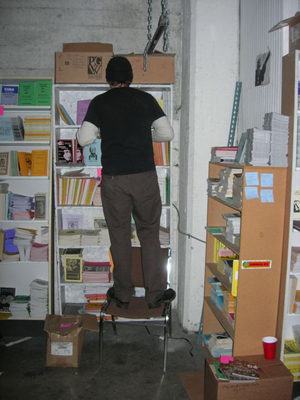 |
Zach counts pamphlets. |
 |
| Macio climbs the pallet shelves. |
 |
Lorna celebrates…and expresses herself. |
Posted on February 28th, 2010 in AK Authors!, Current Events
 (The next installation in our ongoing series of dispatches from the mountains of West Virginia, where the battle against mountaintop removal continues to escalate. AK Press will publish Mountain Justice: Homegrown Resistance to Mountaintop Removal, for the Future of Us All, by journalist Tricia Shapiro, this Fall.)
(The next installation in our ongoing series of dispatches from the mountains of West Virginia, where the battle against mountaintop removal continues to escalate. AK Press will publish Mountain Justice: Homegrown Resistance to Mountaintop Removal, for the Future of Us All, by journalist Tricia Shapiro, this Fall.)
Escalating Sanctions against Mountaintop Removal Protesters
“Protesters Occupy Marfork Coal Co.’s Office in Response to Mounting Violations,” said a press release from the protesters’ supporters at Climate Ground Zero on Thursday morning, Feb. 18.
A news release from Massey Energy, Marfork’s parent company, told rather a different story: “Environmental Terrorists Invade Marfork Coal Company Office…. Three criminals clad in fatigues and carrying chains invaded a company office and chained themselves to chairs in the lobby. A terrified receptionist went into shock and was transported by ambulance to a local hospital…. One of the criminals, Mike Roselle, was a founding member of Earth First!, which is considered by many to be a domestic terrorist group…. These domestic terrorists are part of an anti-coal group that wants to shut down mining in Appalachia and destroy West Virginia’s economy.”
Massey’s “news release” doesn’t specify who those “many” are who consider Mike and his colleagues to be “domestic terrorists.” But even right-wing activist Ron Arnold, who’s written an entire book on “ecoterrorism,” asserts that “Roselle may be a terrible pain in the ass, but he’s no terrorist.” Writing shortly after Mike’s first trespassing arrest on Massey property, at Marfork’s Bee Tree strip mine site a year ago, Arnold scolded those who would “dilute” the meaning of the word terrorism by applying it to nonviolent protest.
“Face it,” he wrote, “what he did was civil disobedience, not terrorism.”
The claim that “a terrified receptionist went into shock” is equally puzzling. “She was definitely startled when we came in,” says Joe Hamsher, one of the three protesters arrested that day. But soon “she calmed down. She was even laughing.”
Protests are not a new experience for Massey workers. Since February of last year, more than 130 arrests have been made at civil-disobedience actions protesting mountaintop-removal (MTR) strip mining for coal in West Virginia. Several of those actions have targeted Marfork, which has begun blasting at its Bee Tree MTR site a short distance from its enormous Brushy Fork impoundment, which holds billions of gallons of liquid coal waste up above the Coal River valley. Anti-MTR activists and local residents are concerned that blasting so close to the impoundment, which is built over abandoned underground coal mine tunnels, risks catastrophic flooding that by Massey’s own estimate could kill close to a thousand people.
The only violence or threats of violence at any of these actions have been directed at the protesters, not vice versa. For example, at a protest rally at the front gate of Massey’s Goals Coal facility last June, a Massey supporter slapped anti-MTR activist Judy Bonds hard enough that she couldn’t move her neck properly for days. Most recently, in January, workers at Marfork’s Bee Tree site blared multiple airhorns, day and night, at three protesters sitting in trees there, risking permanent damage to the protesters’ hearing. At a previous tree sit, last summer, a sitter was threatened with gang rape.
“We were definitely not much of a threat to her,” Joe Hamsher says, referring to the receptionist at the Marfork office. “I mean, we were locked down.” Joe, the first of the three to enter the building that morning, announced “this is a protest,” then immediately sat down and locked himself to a chair. (That’s why they were carrying chains.)
Meanwhile, Mike Roselle posted a sign reading “CLOSED: Stop the Blasting!” on the building’s front door. A Marfork employee tore the sign down, while the third protester, Tom Smyth, took pictures. Then Mike and Tom entered the building and sat down near Joe. Tom chained himself to his chair.
The three protesters had brought with them a “citizen’s arrest warrant” for Marfork’s president. “Since 1994,” the warrant read, “the Marfork Coal Company has committed over 100 documented permit violations…. Marfork’s continued operations in such close proximity to both Marsh Fork Elementary and the Pettus Head Start Program are not only endangering, but also assaulting the children at these locations with coal dust and other particulates floating off of the mine sites owned by Marfork Coal…. Marfork is continuing its operations on the Bee Tree Strip Mine, placing nearby communities in imminent danger. As President of the Marfork Coal Company, you are responsible for the illegal practices of Marfork. Given the absence of any intervention from West Virginia or federal law enforcement, a citizen’s warrant has been issued for your, Christopher L. Blanchard’s, arrest.”
Two hours after the protesters arrived, state police took them away to jail. (When they left, the allegedly terrified receptionist was still at work, showing no ill effects, Joe notes.) The three were charged with trespass, obstruction, and conspiracy– all misdemeanors. Bail was set for Joe and Tom at $5,000 each, for Mike at $7,500. The magistrate specified that the arrestees would have to raise the entire $17,500 in cash, rather than paying a bail bondsman a small fraction of the money, typically 10 percent.
(Nice, artsy video from Climate Ground Zero of the occupation.)
The Massey “news release” cited above quotes the company’s chairman and CEO, Don Blankenship, saying: “These criminals have been allowed to become more and more aggressive with little repercussion.”
In fact, the “repercussion” against anti-MTR protesters in West Virginia has escalated dramatically over the past year. Early on, protesters arrested for trespassing were simply ticketed and released. Now, they’re sent to jail and required to raise large sums of bail money. Even accused murdererers and child molesters are typically permitted to use the services of a bail bondsman, to reduce the amount of cash they have to muster to get out of jail before trial. But West Virginia magistrates are now typically specifying large cash-only
bonds for civil-disobedience arrestees at anti-MTR protests. This has resulted in protesters being kept in jail after their arrests, but before any trial, sometimes for many days, far longer than the norm for such nonviolent offenses. (Of the three Marfork protesters, Joe was bonded out after eight days in custody. Tom and Mike remained in jail.) When protest cases do come to trial, the fines assessed have generally been increasing as well.
In addition to these escalating sanctions in criminal court, Massey lawyers have filed multiple civil suits against protesters arrested on their property. Lawsuits demanding injunctions and so-far unspecified money for “damages” have been filed against dozens of these protesters: one suit in Raleigh County against participants in several protests there early in 2009, one suit in Boone County against participants in an action there, and a separate Raleigh County suit against participants in a tree-sit action last summer. Protesters not actually named in any of these suits have been found in contempt of a court’s injunction for “acting in concert” with one of a suit’s named parties; that ruling is currently being appealed. In addition, Massey recently filed suit in federal court against participants in the January tree-sit protest at Marfork, requesting at least the minimum of $75,000 in damages that would make such a case eligible for federal
court.
At a hearing for the federal lawsuit on Tuesday, Feb. 23, Massey attorney Sam Brock said that activists protesting against Massey “just have to live by the same rules as everybody else.” Sitting in the courtroom that day, I remembered Massey’s 2008 settlement with the federal EPA for thousands of permit violations related to the Clean Water Act: Massey agreed to pay $20 million, although given the number and nature of the violations the EPA could properly have assessed $2 billion or more–100 times as much. (Massey’s own estimate of this prior to the settlement was $1.5 to $7 billion.) Furthermore, just a few weeks ago, in January, a coalition of environmental groups announcing their intent to sue Massey cited documentation that the company’s permit violations had become even more frequent since the EPA settlement.
Would an even-handed application of “the same rules” allow protesters to commit, say, 99 (or more) civil-disobedience actions with impunity before being arrested for one of them?
“While Massey’s lawyers were in court today trying to enjoin anyone anywhere from trespassing on Massey operations,” Vern Haltom, co-director of Coal River Mountain Watch, noted later that day, “Massey was spilling black water [coal waste] from their Martin County, KY, operation. And Pioneer Fuels (NOT a Massey subsidiary) was spilling black water into Clear Fork,” which empties into the Coal River near Marfork’s headquarters, upstream from the town of Whitesville’s public water intake.
“Unfortunately,” Vern says, “our regulators don’t escalate the enforcement of Massey’s repeating violations that are endangering the community with the same vigor that prosecutors and Massey attorneys are suppressing the voices of endangered people,”
CRMW’s other co-director Judy Bonds, 2003 winner of the Goldman Environmental prize and a lifelong resident of Coal River valley, puts it more bluntly: “I believe the justice system in southern West Virginia is discriminatory in favor of the coal industry. I think keep screaming about it is all we can do.”
——————————
Tricia Shapiro has been covering anti-MTR activism as an embedded freelance writer since 2005. Her book Mountain Justice: Homegrown Resistance to Mountaintop Removal, for the Future of Us All will be published by AK Press this fall.


 Wednesday, March 10 at 7:30PM
Wednesday, March 10 at 7:30PM Thursday, March 11 at 7:00PM
Thursday, March 11 at 7:00PM

 Sunday, March 14 at 7:00PM
Sunday, March 14 at 7:00PM
 AK Authors who are speaking solo:
AK Authors who are speaking solo:






 What Kind of Liberation? Women and the Occupation of Iraq
What Kind of Liberation? Women and the Occupation of Iraq




 The Madame Curie Complex: The Hidden History of Women in Science
The Madame Curie Complex: The Hidden History of Women in Science
 Black Music
Black Music By now most folks have heard the story about
By now most folks have heard the story about 

 March 4 Strike and Day of Action To Defend Public Education
March 4 Strike and Day of Action To Defend Public Education


